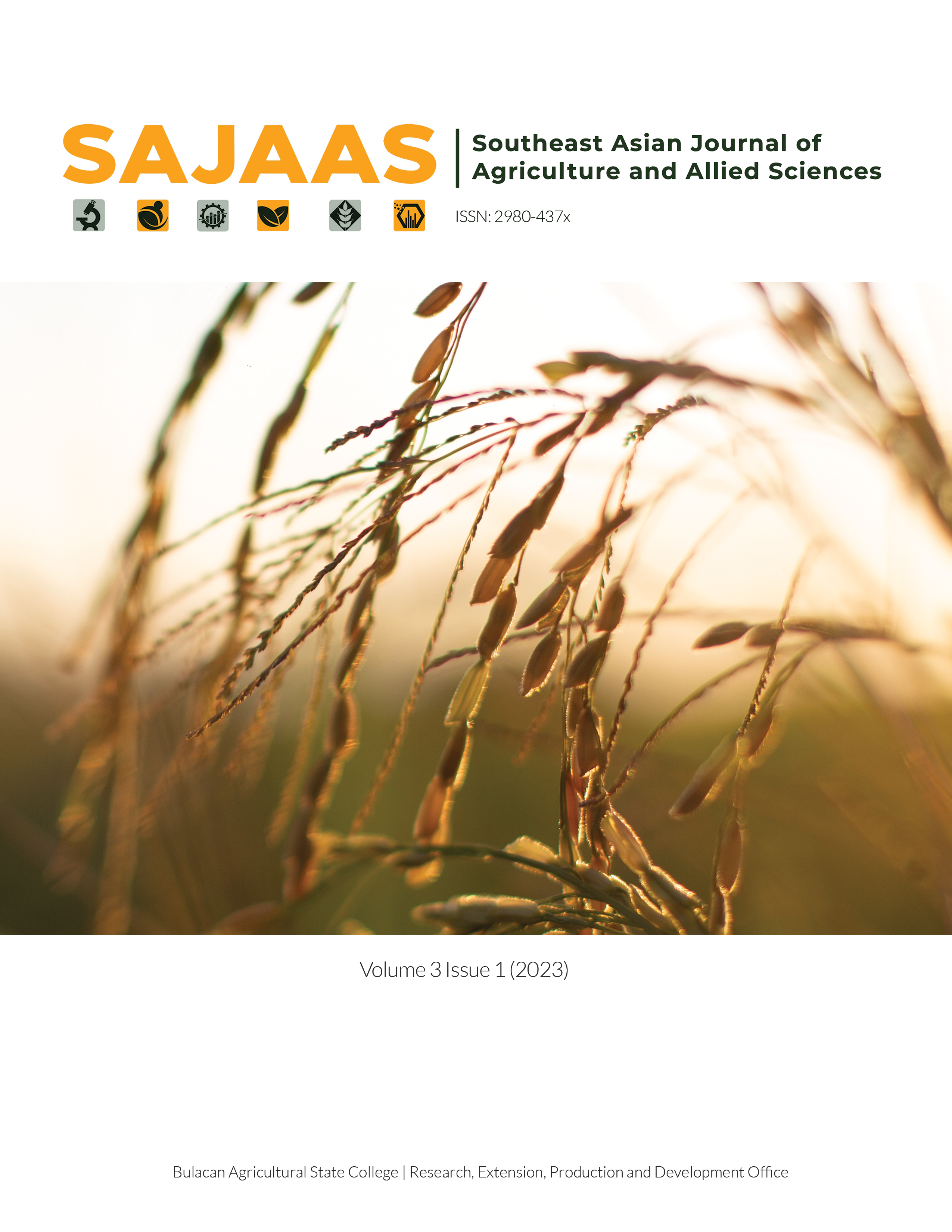Abstract
The microbial fuel cell (MFC) is a system that can efficiently and directly transform several non-purified organic substrates and various waste classes into electrical energy from the activity of bacteria. The performance of the dual chamber MFC system using cow and carabao wastewater were compared under identical conditions. Each set-up comprised anode and cathode with 25L wastewater (cow or carabao), microbial inoculant derived from effective microorganisms and molasses, stainless-steel electrodes, and salt bridge as proton exchange membrane (PEM). In these conditions, the MFC was operated for twenty (20) days and three (3) replications. Maximum power densities per surface area generated were 29.19 mW/m2 for cow wastewater and 10.88 mW/m2 for carabao wastewater. Meanwhile, peak power densities per volume were recorded at 583.87 mW/m3 and 217.51 mW/m3 for cow and carabao wastewater, respectively. Deductively, cow wastewater shows significantly higher results in bioelectricity generation than carabao wastewater. Furthermore, in terms of wastewater treatment, cow wastewater provided a greater TDS reduction efficiency of 41.23% than carabao wastewater, with only 28.59%.
References
Calub, A.D., R.B. Saludes, and E.V.P. Tabing (2016). An Overview of Agricultural Pollution in the Philippines: The Livestock Sector. World Bank.
Choudhury, P., Ray, R. N., Bandyopadhyay, T. K., Tiwari, O. N., & Bhunia, B. (2020). Kinetics and performance evaluation of microbial fuel cell supplied with dairy wastewater with simultaneous power generation. International Journal of Hydrogen Energy, 46(31). https://doi.org/10.1016/j.ijhydene.2020.08.024
Daisog, Dela Cruz, Salazar, Tisca, & Buenavides. (2011). Microbial fuel cell: A new renewable source of energy: Pasig river sediments for lighting. Annual Research Award - ARAW. Retrieved October 7, 2022, from http://scinet.science.ph/union/ShowSearchResult.php?s=2&f=&p=&x=&page =&sid=1&id=Microbial+fuel+cell&Mtype=ANALYTICS.
Department of Energy. (n.d.). Philippine Energy Plan 2020-2040: Towards a Sustainable and Clean Energy Future. Philippine Energy Plan.
Fangzhou, D., Zhenglong, L., Shaoqiang, Y., Beizhen, X., & Hong, L. (2011). Electricity generation directly using human feces wastewater for life support system. Acta Astronautica, 68(9–10), 1537–1547. https://doi.org/10.1016/j.actaastro.2009.12.013
Guang, L., Koomson, D. A., Jingyu, H., Ewusi-Mensah, D., & Miwornunyuie, N. (2020). Performance of exoelectrogenic bacteria used in microbial desalination cell technology. International Journal of Environmental Research and Public Health, 17(3), 1121.
Jiang, H., Luo, S., Shi, X., Dai, M., & Guo, R. (2013). A system combining microbial fuel cell with photobioreactor for continuous domestic wastewater treatment and bioelectricity generation. Journal of Central South University, 20(2), 488–494. https://doi.org/10.1007/s11771-013-1510-2
Li, L. H., Sun, Y. M., Yuan, Z. H., Kong, X. Y., & Li, Y. (2017). Effect of temperature change on power generation of microbial fuel cell. Environmental Technology, 34(13–14), 1929–1934. https://doi.org/10.1080/09593330.2013.828101
Liu, C. (2019). Potassium permanganate as an oxidant for a microfluidic direct formate fuel cell. International Journal of Electrochemical Science, 4557–4570. https://doi.org/10.20964/2019.05.01
Ren, H., Jiang, C., & Chae, J. (2017). Effect of temperature on a miniaturized Microbial Fuel Cell (MFC). Micro and Nano Systems Letters, 5(1). https://doi.org/10.1186/s40486-017-0048-8
Reyes, K. (2020). Bio-Electrochemical Performance of Dual-Chamber Microbial Fuel Cell (Mfc) using Anaerobic Digested Slurry. Hankyong National University.
Sevda, S., Dominguez-Benetton, X., Vanbroekhoven, K., De Wever, H., Sreekrishnan, T. R., & Pant, D. (2012). High strength wastewater treatment accompanied by power generation using air cathode microbial fuel cell. Applied Energy, 105, 194–206. https://doi.org/10.1016/j.apenergy.2012.12.037
Taniguchi, S. (2019). Securing Access to Electricity with Variable Renewable Energy in the Philippines: Learning from the Nordic Model. ADBI Working Paper Series. Retrieved October 7, 2022, from https://www.adb.org/publications/securing-access-electricity-variable-renewable-energy-philippines

This work is licensed under a Creative Commons Attribution-NonCommercial-ShareAlike 4.0 International License.
Copyright (c) 2024 Southeast Asian Journal of Agriculture and Allied Sciences

